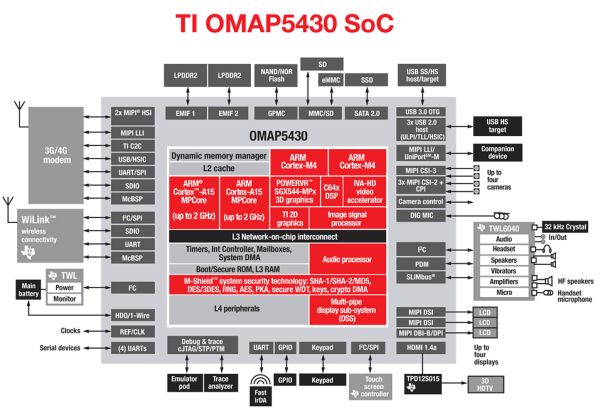TI Reveals OMAP 5: The First ARM Cortex A15 SoC
by Anand Lal Shimpi on February 7, 2011 8:59 PM EST- Posted in
- Smartphones
- OMAP
- Arm
- TI
- Cortex A15
- Mobile
- SoCs
TI sure does have impeccable timing. Not 12 hours after we published our LG Optimus 2X and NVIDIA Tegra 2 review, complete with a discussion of the 2011 SoC space, did TI announce its OMAP 5 SoC.
OMAP 5 will go into production in the second half of 2011 and ship in phones during the second half of 2012. It’s a 28nm SoC with significant architectural upgrades compared to the OMAP 4.
While the OMAP 4 integrates a pair of ARM Cortex A9 cores, OMAP 5 features two ARM Cortex A15 cores. TI already announced that it was ARM’s first licensee of the Cortex A15, so the OMAP 5 announcement is not too surprising.
The ARM Cortex A15 cores can run at speeds of up to 2GHz, although specific frequencies will depend on the OEM implementation. At 2GHz TI claims the pair of Cortex A15s should be 3x the speed of the 1GHz Cortex A9s in the OMAP 4330. At the same clock speed, TI is boasting a 50% performance advantage from the A15 over the A9.
With the OMAP 3 TI had a 256KB L2 used by its single Cortex A8. The OMAP 4 quadrupled L2 cache size to 1MB and shared it among both of its Cortex A9s. TI’s OMAP 5 doubles L2 cache size to 2MB, operating at the CPU clock speed, and it’s once again shared by the SoC’s two CPU cores (in this case Cortex A15s). The OMAP 5 retains the same dual-channel LPDDR2 memory interface from the OMAP 4.
Architecturally we still don’t know much about what makes up a Cortex A15, although I suspect we’ll get more of that in the coming months. Update: It looks like ARM has released some info on the A15. It appears to be a wider, deeper, even more OoO architecture. More on this later.
In our Tegra 2 review I mentioned that the transition from ARM11, to Cortex A8 and now to Cortex A9 left us with a generational performance improvement each step of the way. The move to A15 will be no different. ARM’s Cortex A8 went mainstream in the performance segment in 2010, Cortex A9 will do the same in 2011 and with any luck we’ll see A15 before the end of 2012. It’s this sort of yearly cadence that ARM and its partners must keep up in order to really catch up and surpass what Intel has been promising with Atom. Atom came out in 2008 and it won’t be until late 2012 that its architecture is truly refreshed. For a company that survived the mistakes of NetBurst, Intel doesn’t seem to have learned much of a lesson there.
In addition to its dual Cortex A15 CPUs, the OMAP 5 will feature two ARM Cortex M4 cores as well. The M4 isn’t very useful as a general purpose microprocessor, it only supports the ARM Thumb/Thumb-2 instruction sets (not the full 32-bit ARMv7-A ISA). The M4 does have a suite of signal processing extensions that can be used to accelerate audio/video encode and decode. One application of the M4s will be still picture enhancement. A goal for the next-generation of SoCs is to begin to bridge the gap between smartphone camera quality and high-end point-and-shoot and DSLR cameras. Obviously we’ll always be bound by the poor optics possible on smartphones, however there’s still a lot that can be done in hardware to improve the quality of what’s captured.
The OMAP 5 supports up to four cameras. One demo I saw Intel put together a while ago was of a smartphone with two equal resolution/quality cameras on its back. The only difference between the two was the focal length of the lens. Whenever you took a photo with the demo camera you’d actually capture the scene at two (vastly) different focal lengths. The SoC (in this case an Atom) would use the captured data to produce one image where the entire scene was in focus, with improved sharpness/detail over a single camera solution. It’s possible that OMAP 5 based smartphones may feature similar technologies and use its Cortex M4s to merge/interpolate data from the camera sensors.
As ARM’s CPUs grow in power consumption, the amount of fixed function or specialized silicon set aside to offload various tasks will increase. The Cortex A15s should be used only for those applications that absolutely need them, anything else should be offloaded.
The OMAP 5 SoC integrates Imagination Technologies’ PowerVR SGX 544 GPU, although it’s unclear how many cores will be present in TI’s implementation. Each SGX 544 core has four USSE2 pipes compared to four USSE pipes in the SGX 540, and two USSE pipes in the SGX 530. Each USSE2 pipe offers an increase in compute power compared to the old USSE pipes, however I don’t have details on specific differences in internal organization.
TI announced two versions of the OMAP 5: the 5430 and 5432. The OMAP 5430 features a 14 x 14mm PoP with LPDDR2 memory support, while the 5432 is a larger 17 x 17mm BGA package with DDR3/DDR3L support. The 5430 will likely be used in smartphones while the 5432’s larger size would be better suited for tablets.
On paper alone the OMAP 5 looks to be very powerful, but it needs to be. Also shipping in 2012 will be Qualcomm’s MSM8960 and we may see Project Denver as well. The application processor race hasn’t even begun to heat up, but it’s starting to get interesting.












39 Comments
View All Comments
SPOOFE - Tuesday, February 8, 2011 - link
More megapixels also gives them the wiggle room necessary for digital image stabilization; rather than moving lens elements or the sensor, they shift which pixels on the actual imager correspond to pixels in the resultant picture.But, of course, we all know that the "bigger number" syndrome will always net them a few extra sales.
AnnonymousCoward - Tuesday, February 8, 2011 - link
A negligible percent of people crop images from their compact digital camera.Sufo - Wednesday, February 9, 2011 - link
There was a blog post, it may have been linked in the review comments here, comparing the n8 to a dslr, and in some shots it was arguable which came out on top. Anecdotally, i've seen some great shots taken with it. So yeah, want a decent camera phone - there you have it.strikeback03 - Thursday, February 10, 2011 - link
I never said they couldn't be decent at a single focal length, but for me at least to replace a P&S it is going to have to have optical zoom capability in at least the 28-100mm (equivalent) neighborhood. Now given that this type of thing seems to be more popular in other parts of the world something like what I described might be available in Korea or something, but has not been launched in any major way in the US at least.Wilco1 - Tuesday, February 8, 2011 - link
There is a lot of detail available on the Cortex-A15 - here is a link:http://www.arm.com/files/pdf/AT-Exploring_the_Desi...
- 3-way OoO, window size ~50 instructions
- 15-24 pipeline stages
- 128-bit I-fetch (4-8 instructions)
- 8 execution pipelines with separate issue queues
- 1 load + 1 store per cycle (stores are in-order until address is resolved)
- fully OoO VFP and Neon, quad FMAC per cycle
Anand Lal Shimpi - Tuesday, February 8, 2011 - link
!Thank you for this, I had no idea ARM released all this - digesting now. Looks like I'll have some things to talk to ARM about at MWC next week :)
Take care,
Anand
eddman - Tuesday, February 8, 2011 - link
Actually it's possible that we may see tegra 4 devices before omap 5 ones.Tegra 2 = now (LG Optimus 2X, Motorola Atrix, etc.)
Tegra 2 3D = spring 2011(LG Optimus 3D ?)
Tegra 3 = fall 2011
Tegra 4 (ARM Cortex-A15 ?) = first half of 2012?
@Anand
Do you have any information on tegra 4?
Calabros - Wednesday, February 9, 2011 - link
"the gap between smartphone camera quality and high-end point-and-shoot and DSLR cameras" is because of sensor size. its matter of physics, not technology. OMAP5 like things can only good for those consumer-brain-washer-features you mentioned in article.Kevin G - Friday, February 11, 2011 - link
The thing that stands out in this SoC is that addition of a USB 3.0 and SATA port. USB 3.0 can arguably be useful on a smart phone I'm struggling to see where SATA would come into play. I have a feeling that TI is broadening the range of devices this SoC can be placed into.